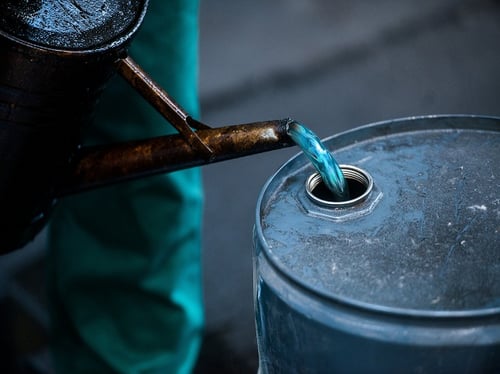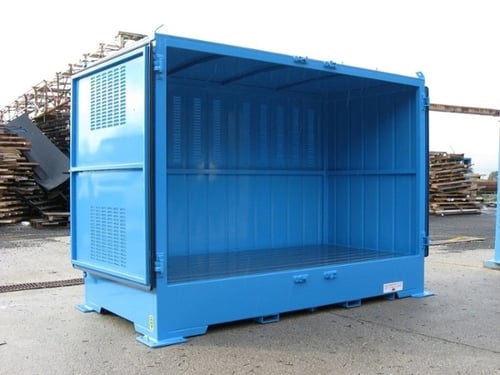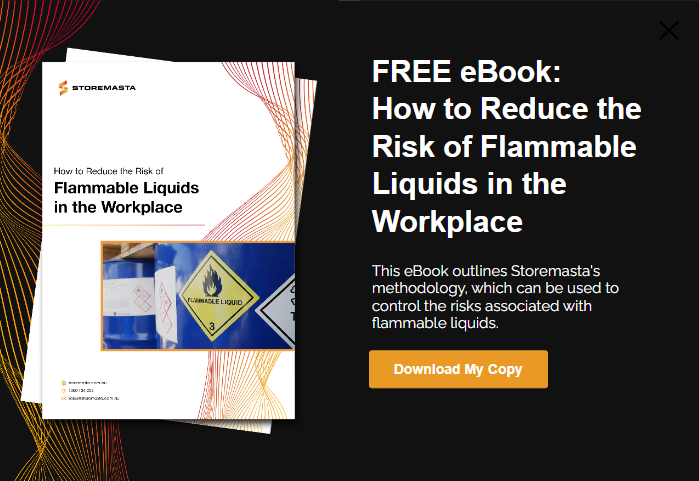How are you storing your Class 3 Dangerous Goods? According to the Australian Dangerous Goods Code, Class 3 Flammable Liquids are defined as liquids that will ignite in the presence of an ignition source at temperatures below 60 °C. Because of their volatility, flammable liquids must be stored in a safe and compliant manner to reduce risk. If you’re unsure that you’re meeting the requirements for indoor and outdoor storage, this blog will help you determine your needs.
Meeting the Requirements of the Australian Standards
Safe storage of flammable liquids can be achieved by adhering to the requirements outlined in the Australian Standards. The Standard that outlines the requirements for the storage and handling of flammable liquids is AS 1940 – The handling and storage of flammable and combustible liquids.
To reduce the many risks associated with flammable liquids in the workplace, the Standard details various requirements for both indoor and outdoor storage.
Indoor Class 3 Cabinet or Outdoor Flammable Store?
One of the most common questions customers ask our Dangerous Goods Storage Consultants is: ‘Should I store my flammable liquids indoors or outside?’ And like many Work Health and Safety questions, the answer usually is: ‘That depends…’.
From the presence of ignition sources to everyday wear and tear, there are many factors to consider when deciding whether to store your substances in an indoor or outdoor flammable liquids cabinet. By assessing your workplace and considering a range of essential factors, you’ll be able to properly determine if you need to store your flammable liquids in an indoor or outdoor environment.
In the next section of our post, we’ll key requirements for the indoor and outdoor storage of flammable liquids, as per the detailed requirements of the Australian Standards. Firstly, we’ll start with the maximum capacity allowed for indoor storage of Class 3 substances.
Maximum Capacity for Indoor Storage of Flammable Liquids
As flammable liquids pose risks including fire, explosion, asphyxiation, human harm and environmental damage, it’s vital that workplaces limit the quantity of flammable liquids stored indoors.
In Section 4.9 of AS 1940, you’ll find that the maximum capacity requirements for indoor flammable liquids storage cabinets.

Class 3 liquids include a range of commonly found substances including fuel, acetone and methylated spirits.
If the flammable cabinets are located on a floor other than the ground floor, the aggregate capacity of the flammable liquids storage cabinets should not be greater than 250L per 250 m2 of floor space. Each aggregate quantity must be separated by a distance of at least 10 m.
If your cabinets are larger than 250L, they can’t be installed in a range of premises including hospitals, aged care facilities, school buildings, accommodation or residential buildings and commercial buildings. These larger flammable cabinets must only be installed on floors with direct access from the street or ground level.
Regardless of the quantities of Class 3 liquids that you hold, you must still consider the following when positioning your flammable cabinet or cabinets:
- Cabinets must not impede emergency evacuations
- Ignition sources (ie. Heat, sparks, flame, friction, static) must be identified and excluded from the area by at distance of at least 3m
- Segregation of Class 3 liquids from other incompatible substances
If you need to store more than 850L of flammable liquids per 250 m2 of floor space — or you can’t apply these installation location requirements to your indoor workspace — you will have to invest in a custom-built fire rated flammable liquids storage facility or store your flammable liquids outdoors.
We’ll take a closer look at the requirements for outdoor storage a little later in the blog.
What Makes a Flammable Liquids Storage Cabinet Compliant?
When flammable liquids are stored indoors, it’s very important to ensure that they are kept in a flammable cabinet that has been designed and constructed in full conformance to AS 1940. This will give your business the best protection against the risks and hazards associated with the storage of Class 3 liquids.
To determine the compliance of your cabinet, simply check with your manufacturer or supplier to see if the cabinet has been constructed to meet all the requirements of the Australian Standard.
Section 4.9.2 of AS 1940 outlines the many requirements for flammable liquids storage cabinets.
The main requirements for the construction of flammable liquids storage cabinets include:
- CONSTRUCTION - The walls, floor, doors and roof of the cabinet must be a dual skinned sheet metal construction with a space of at least 40 mm between the walls.
- NON-COMBUSTIBLE MATERIALS - The materials that are critical to the structural integrity of the cabinet must not melt at temperatures below 850 °C.
- AUTO RELEASE - Where the doors are equipped with a device to hold them open when necessary, they must automatically release at temperatures exceeding 850 °C.
- DOORS - Cabinet doors must be self-closing close-fitting and automatically held shut by catches at two or more points.
- SPILL CONTAINMENT - The spill containment sump in the base of the cabinet must be at least 150mm deep and shall be designed to prevent packages from being stored inside it.
- CHEMICAL LEAKS - The cabinet must be designed so that all leakages inside the cabinet are directed into the spill containmentsump in the bottom of the cabinet.
- FREE AIR MOVEMENT - All shelves inside the cabinet must be perforated to allow for free air movement within the cabinet.
- THERMAL PROTECTION - All gaps around the doors shall be sealed to prevent the spread of flames or heat radiation.
Requirements for the Outdoor Storage of Flammable Liquids
Outdoor storage of flammable liquids will reduce the risk of property damage and harm to your people in the event of a fire or explosion. While you’ll have to refer to your Safety Data Sheet and risk assessment to determine the feasibility of outdoor chemical storage, many organisations choose outdoor chemical storage containers to store larger quantities of flammable liquids.
What Makes an Outdoor Flammable Liquids Storage Container Compliant?
The requirements for the construction of outdoor flammable liquids storage containers are featured in Section 4.1 - 4.8 of AS 1940. These requirements differ from those of indoor flammable cabinets. Two features that are not required for outdoor flammable liquids storage containers include self-closing self-latching doors and dual-skinned construction.

Outdoor chemical storage containers for flammable liquids should be constructed to meet the requirements of AS 1940.
The mandatory requirements for compliant chemical storage containers are outlined below:
Spillage Containment
Flammable liquids storage containers must have the provision to contain any leaks or spills that may occur. To achieve this, all flammable liquids storage containers must have a spill containment sump in the lower part of the container. The required spill containment capacity of flammable liquids storage containers depends on the quantity of flammable liquids being stored within the container.
The spill containment capacities for outdoor flammable storage cabinets are outlined below:
Facilities storing less than 10,000L
Spill containment capacity = 100% of the largest package within the store + 25% of the aggregate capacity of the store.
Facilities storing between 10,000L - 100,000L
Spill containment capacity = 100% of the largest package within the store + 25% of the aggregate capacity of the store + 10% of storage capacity between 10,000L and 100,000L.
Facilities storing more than 100,000L
Spill containment capacity = 100% or the largest package within the store + 25% of the aggregate capacity of the store + 10% of storage capacity between 10,000L and 100,000L + 5% of the storage capacity exceeding 100,000.
Ventilation
Class 3 liquids can emit large amounts of flammable vapours. If these flammable vapours reach an ignition source, such as hot work, faulty electrical equipment or a naked flame, it can result in a severe fire or explosion.
To reduce the risk of ignition, an outdoor flammable storage cabinet must be ventilated to reduce the build-up of flammable vapours within the store. Because of the size of outdoor flammable liquids storage containers, a natural ventilation system is the most practical form of ventilation. AS 1940 states that a natural ventilation system on a flammable liquids store can be achieved by having two walls of fixed louvers open to the air.
What’s The Difference Between an Indoor and Outdoor Flammable Liquids Cabinet?
If you’re searching for the safest, most efficient way to store Class 3 Dangerous Goods, you’ll need to get an understanding of the features of an indoor and outdoor flammable liquids cabinet, so you can decide which cabinet will suit your specific requirements.
To make the flammable liquids storage selection easier, we’ve collated all the features of indoor and outdoor flammable cabinets in a comparison table below.
By understanding how the specific cabinet features can control your unique workplace risks and hazards, you’ll be able to select the right Class 3 storage for your operations.
| Feature | Indoor Flammable Cabinets | Outdoor Flammable Cabinets/Containers |
| Thermal Protection |
Indoor cabinets have dual-skinned walls and provide a level of thermal protection between the chemicals inside the cabinet and the exterior temperature. |
Outdoor cabinets don’t provide a thermal barrier but utilise natural ventilation to allow the air inside to move freely. |
|
Ventilation |
Indoor cabinets hold vapours and fumes and require an adjunct mechanical ventilation system if chemical concentrations cannot be maintained within workplace exposure standards. |
Outdoor flammable cabinets provide natural ventilation because they have single skin louvered walls. |
|
Spill Containment |
Indoor cabinets with a capacity between 30L and 250L have a liquid tight spill sump that is at least 150mm deep. Indoor cabinets that have a capacity between 250L and 850L have a spill sump that is 150mm deep and capable of holding at least 25% of the aggregate capacity of the cabinet. |
The capacity of the spill containment sump must be at least 100% of the volume of the largest package inside the store, plus 25% of the storage capacity up to 10 000L, together with 10% of the storage capacity between 10 000L and 100 000L, and 5% above 100 000L. |
|
Weather Protection |
Indoor cabinets have flat roofs and are not designed for rain protection. |
Outdoor stores have cambered roofs that are engineered to maximise rainwater runoff. Outdoor stores are single-walled and vented so rainwater isn’t a problem. |
|
Stability |
Indoor cabinets cannot be fixed to the ground. |
Outdoor stores have engineered base plates and can be permanently fixed to the ground. That way they can’t blow over in a strong wind or be knocked over by a vehicle. |
|
Impact Protection |
Indoor cabinets are constructed from double-walled sheet steel and offer some impact protection. |
Outdoor cabinets are built from 25% stronger materials for greater impact protection. |
|
Cabinet Size |
The maximum size for an indoor flammable liquids cabinet is 850 litres. |
There is no limit to the size of an outdoor store. |
|
Security |
Indoor cabinets have self-closing, close-fitting doors that latch at 2 points. These doors are also lockable. |
Outdoor cabinets have ISO locking bars that can be padlocked to secure the chemicals from theft. |
|
Portability |
Indoor Class 3 cabinets are not designed to be moved around the site. |
When empty, Storemasta outdoor chemical stores are 100% portable and have forklift channels and lifting lugs for easy relocation. |
|
Grounding |
Indoor cabinets have no additional fittings for grounding. |
Outdoor cabinets have earth stake mountings to dissipate static discharge. |
Operational Requirements for Indoor Flammable Liquids Storage Cabinet
Storing flammable liquids in an indoor safety cabinet is an excellent start to meeting legislative compliance. However, there are other operational requirements for meeting full compliance.
These operational requirements include:
- IGNITION SOURCES - Flammable liquids storage cabinets must be separated from all ignition sourcesby at least 3 metres. No ignition sources must be placed inside the cabinet.
- STACKING - Drums with a capacity greater than 60L must not be stackedmore than 2 high within the cabinet.
- SIGNAGE - Flammable liquids storage cabinets must be marked with a sign “No Smoking No Ignition Sources Within 3m” and a class 3 dangerous goods label with sides at least 250 mm long.
- INCOMPATIBLE SUBSTANCES - All other dangerous substances that are incompatible with flammable liquids must not be stored within cabinet.
As we’ve highlighted here, it’s essential to ensure that your safety cabinet meets the requirements of AS 1940 to ensure you have sufficient protection from the hazards associated with your flammable liquids..
We also highly recommend developing procedures and training so that your staff can confidently follow the operational safety requirements that are laid out in the Australian Standard.
REMEMBER: If the quantity of flammable liquids that you’re storing exceeds the maximum capacity outlined in Section 4.9, you must store your chemicals in an outdoor location for the safety of people, property and the environment.
Operational Requirements for Outdoor Flammable Storage Cabinet
To achieve full compliance with your outdoor store, there are several other operational requirements that must be followed. It’s a good idea that you familise yourself with the operational requirements for your store before it arrives onsite, as this allows for the seamless installation and maintenance of your flammable liquids store.
The operational requirements for outdoor flammable storage containers include:
- IGNITION SOURCES - Flammable liquids storage containers must be separated from all ignition sourcesby at least 3 metres. No ignition sources must be placed inside the container.
- DG LABEL - All flammable liquids storage containers must be marked with a class 3 dangerous goods label that has sides of at least 250mm.
- SIGNAGE - Flammable liquids storage containers must also have a sign that states “No Smoking No Ignition Sources within 3m”
- EYE WASH STATION – All flammable liquids storage facilities must have a eye wash station within 10 metres, but no nearer than 2 metres.
- SAFETY SHOWER - If the flammable liquids storage container has a capacity greater than 2000L, a safety showermust be located within 10 metres, but not nearer than 2 metres.
Safe Indoor and Outdoor Storage Of Flammable Liquids
Thanks for reading our blog on the requirements for indoor and outdoor storage of Class 3 Flammable Liquids. As we’ve highlighted, indoor storage and outdoor storage of flammable liquids pose different levels of risk upon the people and property of the workplace. To adequately protect your workplace, the environment and your community, it’s vital that you adhere to the different requirements of AS 1940 that are in place for indoor and outdoor storage.
If you’d like to know more flammable liquids storage, why not access our helpful guide? How To Reduce The Risk Of Flammable Liquids In The Workplace will introduce you to our risk control methodology and take you step-by-step through the processes necessary for chemical compliance. Simply click on the image below to grab your free copy today.

Living life by the 4 C’s of marketing – communication, coffee, compliance… and more coffee – Leisa Andersen is Storemasta’s Content Marketing Manager. When she’s not writing, you’ll find her enjoying all the good things in life, including shopping, travel and gluten free donuts.
